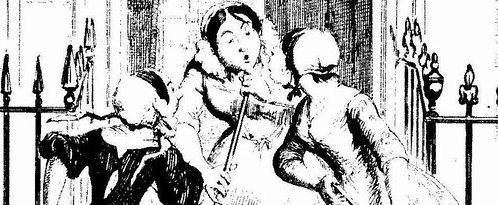But where's the loo?

It was in the Indian city of Varanasi that I first realised that provision of lavatory facilities is a feminist issue. Simply there are none, or at least weren't when I was there eight or so years ago. For the men this wasn't a problem; they just went anywhere. (One of the many things in Varanasi that contribute to it being a total hole of a place - if someone tells you to put it on their tour itinerary, ignore them.)
Women's movements were effectively restricted to the range of their home, and the homes of any relatives or friends that might be along their intended route.
The above image is of London, Kensington High Street, about 1860. Then the same restrictions applied on Englishwomen.
"The middle-class diarist Ursula Bloom explained that when she was a girl 'there were no public lavatories in England, and it was thought the height of indecency ever to desire anything of the sort.' She went on to recall that 'in London fashionable ladies went for a day's shopping with no hope of any relief for those faithful tides of nature until they returned home again.' ...
Edith Hall, a working-class woman who was born in Middlesex in 1908, recalled that while walking with her mother along the Thames during the First World War, she asked, 'There aren't many lavatories for ladies, are there?' Her mother matter-of-factly answered: ' Well, we are more lucky now ... There didn't seem to be any at all when we were young ... Either ladies didn't go out or ladies didn't 'go'.' " (Quoted in Shopping for Pleasure: Women in the Making of London's West End, Erika Diane Rappaport, Princeton University Press, 2000, p. 82)
This also brings back memories of my agricultural science studies (my first degree - my only explanation is that I was only 17 when I chose it). We were the first year in which women were a majority, and the first-year excursion included virtually no facilities. Only wholesale revolts forced the bus to wait for the long queue using each farmer's one and only loo. (And this was in northwest NSW, so no trees as an alternative option.)
*Image from Old and New London, By Edward Walford, Illustrated, Part 49, hard to date, but perhaps 1890s.)
History







3 Comments:
Did they not just use pubs like people do today? Or did public houses and restaurants not have toilets either?
Women, or at least _ladies_ couldn't possibly be seen in such places. (And the facilities would anyway probably have been very rudimentary.)
The mention of India when it comes to toilet facilities reminds me very vividly of an experience I had coming back to London from Bangalore via Mumbai airport. While Bangalore had a "proper" Ladies, the major international terminal at Mumbai only had the lovely "hole in the ground" facilities - complete with mosquitoes. Navigating this in jeans (it was only early March, and I was dressed for the weather when I got to Heathrow) wasn't really fun, but I'll never forget the faces of the attendants when I emerged, having done so. I think they expected me to run away screaming....
The most baffling thing was why there were modern facilities at Bangalore (which, although it's the general business centre these days, especially in terms of outsourcing, is still only a small domestic airport) but not at Mumbai, one of the largest international terminals in the country.
Post a Comment
<< Home